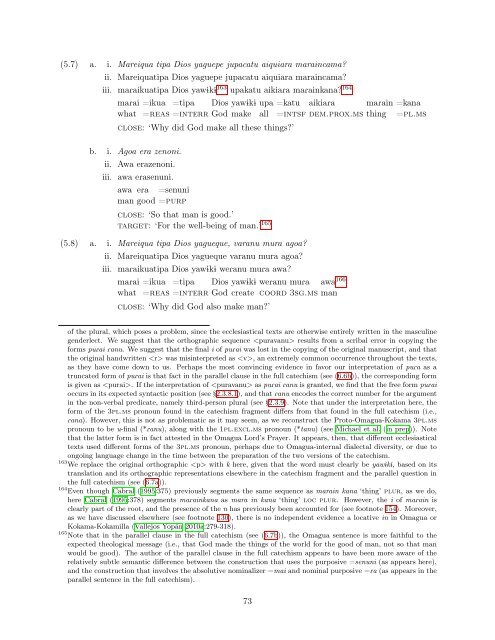draft manuscript - Linguistics - University of California, Berkeley
draft manuscript - Linguistics - University of California, Berkeley
draft manuscript - Linguistics - University of California, Berkeley
You also want an ePaper? Increase the reach of your titles
YUMPU automatically turns print PDFs into web optimized ePapers that Google loves.
(5.7) a. i. Mareiqua tipa Dios yaguepe jupacatu aiquiara maraincama?<br />
ii. Mareiquatipa Dios yaguepe jupacatu aiquiara maraincama?<br />
iii. maRaikuatipa Dios yaw1k1 163 upakatu aikiaRa maRainkana? 164<br />
maRai<br />
what<br />
=ikua =tipa Dios yaw1k1 upa =katu aikiaRa maRain =kana<br />
=reas =interr God make all =intsf dem.prox.ms thing =pl.ms<br />
close: ‘Why did God make all these things?’<br />
b. i. Agoa era zenoni.<br />
ii. Awa erazenoni.<br />
iii. awa eRasenuni.<br />
awa eRa =senuni<br />
man good =purp<br />
close: ‘So that man is good.’<br />
target: ‘For the well-being <strong>of</strong> man.’ 165<br />
(5.8) a. i. Mareiqua tipa Dios yagueque, varanu mura agoa?<br />
ii. Mareiquatipa Dios yagueque varanu mura agoa?<br />
iii. maRaikuatipa Dios yaw1k1 weRanu muRa awa?<br />
maRai<br />
what<br />
=ikua =tipa Dios yaw1k1 weRanu muRa awa 166<br />
=reas =interr God create coord 3sg.ms man<br />
close: ‘Why did God also make man?’<br />
<strong>of</strong> the plural, which poses a problem, since the ecclesiastical texts are otherwise entirely written in the masculine<br />
genderlect. We suggest that the orthographic sequence results from a scribal error in copying the<br />
forms puRai Ranu. We suggest that the final i <strong>of</strong> puRai was lost in the copying <strong>of</strong> the original <strong>manuscript</strong>, and that<br />
the original handwritten was misinterpreted as , an extremely common occurrence throughout the texts,<br />
as they have come down to us. Perhaps the most convincing evidence in favor our interpretation <strong>of</strong> puRa as a<br />
truncated form <strong>of</strong> puRai is that fact in the parallel clause in the full catechism (see (6.6b)), the corresponding form<br />
is given as . If the interpretation <strong>of</strong> as puRai Ranu is granted, we find that the free form puRai<br />
occurs in its expected syntactic position (see §2.3.8.1), and that Ranu encodes the correct number for the argument<br />
in the non-verbal predicate, namely third-person plural (see §2.3.9). Note that under the interpretation here, the<br />
form <strong>of</strong> the 3pl.ms pronoun found in the catechism fragment differs from that found in the full catechism (i.e.,<br />
Rana). However, this is not as problematic as it may seem, as we reconstruct the Proto-Omagua-Kokama 3pl.ms<br />
pronoun to be u-final (*Ranu), along with the 1pl.excl.ms pronoun (*tanu) (see Michael et al. (in prep)). Note<br />
that the latter form is in fact attested in the Omagua Lord’s Prayer. It appears, then, that different ecclesiastical<br />
texts used different forms <strong>of</strong> the 3pl.ms pronoun, perhaps due to Omagua-internal dialectal diversity, or due to<br />
ongoing language change in the time between the preparation <strong>of</strong> the two versions <strong>of</strong> the catechism.<br />
163 We replace the original orthographic with k here, given that the word must clearly be yaw1k1, based on its<br />
translation and its orthographic representations elsewhere in the catechism fragment and the parallel question in<br />
the full catechism (see (6.7a)).<br />
164 Even though Cabral (1995:375) previously segments the same sequence as marain kana ‘thing’ plur, as we do,<br />
here Cabral (1995:378) segments maRainkana as mara in kana ‘thing’ loc plur. However, the i <strong>of</strong> maRain is<br />
clearly part <strong>of</strong> the root, and the presence <strong>of</strong> the n has previously been accounted for (see footnote 154). Moreover,<br />
as we have discussed elsewhere (see footnote 130), there is no independent evidence a locative in in Omagua or<br />
Kokama-Kokamilla (Vallejos Yopán 2010a:279-318).<br />
165 Note that in the parallel clause in the full catechism (see (6.7b)), the Omagua sentence is more faithful to the<br />
expected theological message (i.e., that God made the things <strong>of</strong> the world for the good <strong>of</strong> man, not so that man<br />
would be good). The author <strong>of</strong> the parallel clause in the full catechism appears to have been more aware <strong>of</strong> the<br />
relatively subtle semantic difference between the construction that uses the purposive =senuni (as appears here),<br />
and the construction that involves the absolutive nominalizer =mai and nominal purposive =Ra (as appears in the<br />
parallel sentence in the full catechism).<br />
73
















